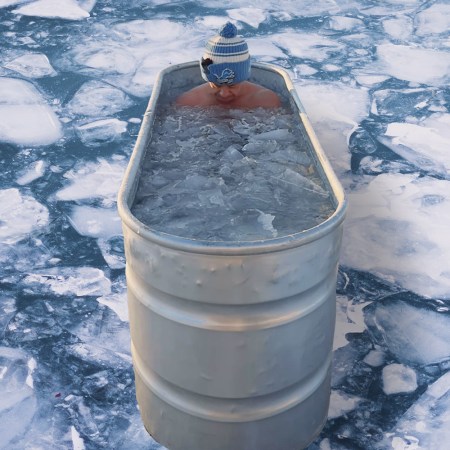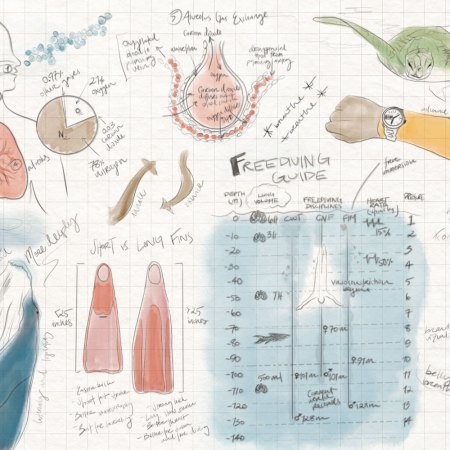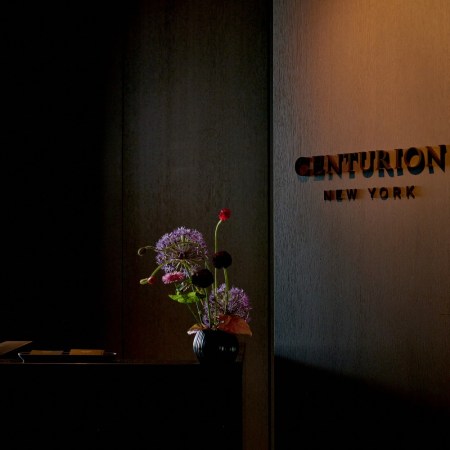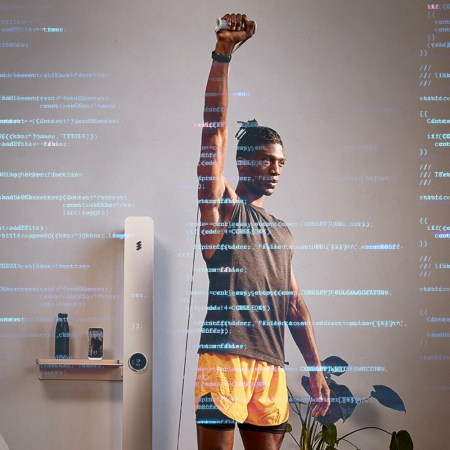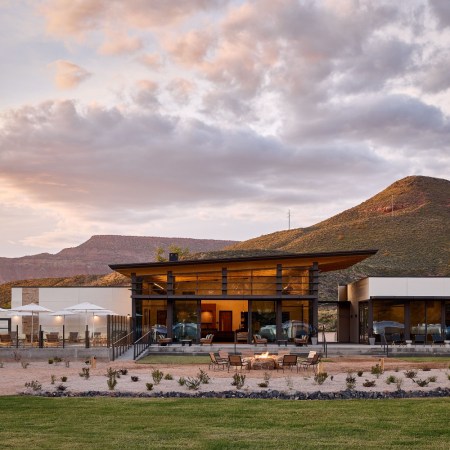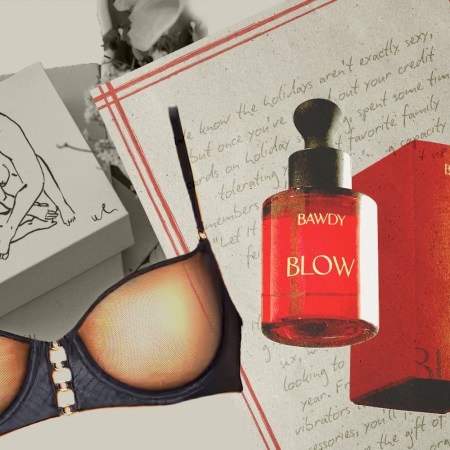In early 2020, as the pandemic was rearing its ugliest head, a Toronto couple decided to build an ice bath in their backyard. Robbie and Emily Bent set up an adjacent fire, too, and invited a few close friends into the project: Amanda Laine, Harry Taylor and Myles Farmer. Before long, the five of them started hosting dedicated sessions: dunk yourself in the frigid water, warm your bones by the flames, repeat. Word got around.
“[People started] using it for free,” Robbie Bent told InsideHook. “If you knew where it was, you could just let yourself in. There was a WhatsApp group that grew to 300 people. It helped create connections in the neighborhood.”
Inevitably, the coldest months returned (the city’s average daily high in winter is 39°F), and the operation moved indoors, to a neighborhood garage, which the troupe outfitted with a sauna. A community of 300 became 1,000, and Bent and Co. began to riff on their original classes.
On Valentine’s Day, Laine and Taylor led an aufguss session in the sauna, which involves diffusing oils and spinning towels with the self-assuredness of a pizzaiolo. It makes a room very hot. Making it even hotter: guided eye-gazing between couples. “These were mini, emotional wellness classes,” Bent said. “On other days we’d have ‘anger release.’ We’d go into the sauna, turn off all the lights and play a drum. People would share what made them really angry and scream…everybody was crying and having such a good time.”
About a year after the Cupid-themed class, the five friends became five founders, officially opening a 3,000-square-foot immersive spa called Othership in Toronto’s Fashion District. Its logo invoked a stretched-out UFO, and the space was described by Toronto Life as “next-gen Soho House for the Burning Man set with a lounge for late-night hangouts.”
The extraterrestrial facility featured muted, modern elements (leather stadium seating, riverstone tiles, petrified wood, as if these aliens were avid readers of Arch Digest), and of course, the goods: a 50-person sauna and a bunker of ice baths, marketed as the coldest commercial plunges in all of North America.
“We had this idea that there may be a market for mainstream people who work nine-to-five jobs that are struggling with living in a big city and stress,” Bent said. They were right. A second property opened earlier this year, in Toronto’s Yorkville neighborhood. And mere months later, Othership landed in the most stressed city in the space-time continuum, opening a 7,000-square-foot facility in New York’s Flatiron District.

Beam Me Up
I visited Othership on a revolting Friday in early August. The temperature was over 90 degrees, the humidity index over 80%. The M train had my girlfriend, Xanthe, and I beleaguered, irritable…and, sorry, moist, well before we made it to the Manhattan mothership’s 170-degree sauna. Summertime in the city.
In other words, the bar was on the floor. I would’ve welcomed any sort of sanctuary, and at best, I was expecting a concept similar to Bathhouse or Remedy Place.
The former pioneered the 2020s wave of recovery-fitness sanctums (I used to live a block from its original Williamsburg location, and have popped by a few times), while the latter tapped into the wealthy Angeleno’s proclivity for holistic treatments: infrared light sauna, acupuncture, cupping rooms, hyperbaric chambers. (I visited the facility in early 2023). Both now have Flatiron locations of their own, and each offers a combination of cold plunges and saunas.
Othership isn’t a carbon copy of its competitors, though. For starters, it looks different, trading the Greco-Roman trappings of those similar spas (nude nymphs in mosaic, giant slabs of stone, olive trees) for dusty reds and greens and browns. The wall’s sooty tapestries call to mind a temple on Arrakis. Meanwhile, the Othership logo finds its physical form as a hazy doughnut in the middle of a cavernous tea lounge, which greets you the second you leave the locker room.
The experience is different, too. Even though we arrived for a self-guided Free Flow session — 75 minutes to test the amenities at our leisure — a pair of affable guides, clad in robes, bathing suits and Finnish “banya bonnets” (wool sauna caps, meant to keep the head cool), informed us that Othership is conceived as an intentional circuit. The spa subscribes to an increasingly popular concept, which goes by a variety of names: contrast therapy, contrast bathing or state-shifting.
In the simplest sense: hot, cold, repeat. In practical terms: 15 minutes in the 170-degree sauna, followed by a quick rinse in the communal showers, capped off by two minutes in the 42-degree ice plunge. Othership guides recommend four circuits total throughout your 75-minute session, which should leave enough time for tea breaks, stretching, chatting with strangers, what have you. If you want to leave feeling energetic, finish with an ice bath. If you want to leave feeling relaxed, finish with a sauna session.
What It’s Like to Take a VO2 Max Test (and Why You Should)
They’re no longer just for Olympians. Take one today and live more tomorrows.I can’t say I was keen to start with the sauna, considering the oppressive heat dome outside, but “sauna first” appeared to be the conventional wisdom. We entered the sauna — it’s the biggest one I’ve seen in NYC — and carved out some personal space on the top deck. There were four-point headrests made from red cedar (surprisingly comfortable), gua sha available for the face, and intermittent visits from guides, who’d drop snowballs on the stove, disperse scents of citrus and lemongrass, and stage mini aufguss performances.
Once time was up, we took our requisite showers and toed into the cold bath chapel, which featured six tubs, each with a wall-set digital clock counting seconds in red. There was the same amount of people in here as in the sauna, but it felt like more — they were either watching their friends in earnest, or milling about the wet tiles, waiting their turn. Those in the tubs were sibilating like dragons; their hissing exhales bounced off the dark walls as they clutched the edges of the steel stock tanks.
I tapped out after only a minute my first time in the bath. (Xanthe watched me, then beat me by 10 seconds or so. I am not salty.) For the uninitiated, know that lowering yourself into an industrial ice bath is not the same as taking a cold rinse in the shower. The cold is pain and the pain is all-encompassing; it shares more DNA with a two-minute plank, or an 800-meter repeat in a track workout, or that torture device in the The Princess Bride‘s Pit of Despair. You’re just there, holding on, hanging on. Oh, and your feet feel like they’re getting a fish pedicure, except the fish are piranhas.
On our second, third and fourth times through, Xanthe and I both eclipsed two minutes in the ice bath. What happened? We received two critical pieces of advice. One: focus on the first 30. Once you make it a half-minute in, the body goes numb. You’re nowhere near home-free from there, but it should feel downhill — if you can lock in. As for locking in: that’s entirely dependent on your breath. You must make a concerted effort to release a consistent stream of long exhales, one guide instructed us. If your breath starts freaking out, you’ll start freaking out.

Is This Legit?
Earlier this summer, during an impromptu interview at the Olympics, a reporter asked Novak Djokovic to name the most important thing that his fellow athletes could do to take care of themselves during the Paris Games.
“It’s a great question,” Djokovic replied. “I think probably the number one thing is to learn how to consciously breathe. It sounds weird, because obviously we all know how to breathe — it’s automatic — but I think…really learning how to master that skill, it helps with better sleep, better recovery, more presence in the moment. We always travel from past to future. Breathing really centers you.”
It was a generous answer from the soon-to-be gold medalist, but also one — you can tell from the video — that he was extremely excited to give. Breathwork acolytes are passionate about their practice; and while Djokovic is a prominent example, millions of believers have emerged in the “James Nestor era” (the science journalist and author’s Breath: The New Science of a Lost Art became an international bestseller in 2020). We interviewed Nestor in 2023, and as he told us at the time, “There’s irrefutable scientific evidence that this physiological, biological act we do 20,000 times a day…has a huge impact on how we feel, physically and mentally.”
Contrast therapy — and specifically the cold plunge portion of it — is an example of a situation that compels “conscious breathing” (to paraphrase the tennis star). It might be one of our very best opportunities for stress reduction, mood regulation and even pain reduction. Other practices come to mind, like meditation or martial arts, but the first is notoriously tricky, while the discipline required for the latter can be a turn-off for many people.
Cold plunges, though? They’re quick, accessible and in. As in as anything could be these days. Influencers are putting $5,000 models in their backyards, “coldwater collectives” have proliferated from Maine to Australia, and Bradley Cooper — in what may be the definitive wellness photo of our time — has broadcasted his love of floating in an icy creek.
I asked Kira Mae Kazuko, a breathwork expert, instructor for Alo Moves and artist-in-residence at Equinox, to offer some context on the relationship between deep breathing and braving two minutes in a cold plunge.
“I always tell my clients to inhale through the nose for four seconds and exhale slowly out of your mouth for eight seconds,” she said. “My best tips for staying calm during any situation, but specifically the cold plunge, is to accentuate the exhale. It sets into motion our parasympathetic nervous system, which is the rest and digest state we need. This allows our nervous system to relax, which then has a domino effect on relaxing our mind and body.”
How about if you get into the habit of doing this all the time, and mimic Cooper — who purportedly gave the photographer for The New York Times ample time to take that photo, as he stayed in the creek for 11 minutes! — or fellow ice-bath acolytes Hugh Jackman, Laird Hamilton, Kim Kardashian, Tim Ferris and the Snow Miser himself, the cold bath-pioneering Dutchman Wim Hof. (Kazuko is one of just 250 certified “Wim Hof Instructors” in North America.) Would those breath-related mental and physical benefits just compound?
“The main mental benefits I’ve noticed are fewer symptoms of anxiety and depression, ease of emotion, positive outlook on life and a sense of presence,” Kazuko said. “The main physical benefits are improved sleep, better stamina when exercising, better digestion and overall stress reduction.”
Dr. Christopher Minson, a professor of human physiology at the University of Oregon who specializes in exercise medicine and thermoregulation, among other areas of study, says it’s true, finding an avenue to tap into conscious breathwork is a worthy use of one’s time. “There is good evidence that practicing slow breathing and relaxation techniques can calm the mind and help us tolerate uncomfortable challenges,” he said. “The benefits here are similar to meditation and other relaxation techniques.”
But he’s unsure what to make of contrast therapy’s core pitch: that shifting from hot to cold, there and back again, provides some special cocktail of focus, energy and recovery. “There is not a lot of direct research on this topic,” he said. “There are relatively few studies that have looked at specific health biomarkers during or immediately after this type of contrast therapy, or with chronic use (as in exercise training).”
Like Minson, Dr. Andrew Jagim, the director of sports medicine research at the Mayo Clinic Health System, is skeptical of state-shifting. “It is possible to shift from a parasympathetic (restful) state to a sympathetic (arousal) state, but the benefits of doing so are somewhat exaggerated and mostly marketing jargon,” he said. “Context is important for when and why shifting states may be helpful.”
In recent months, some researchers have questioned the impact of cold plunges (one oft-cited study is entitled “Postexercise cooling impairs muscle protein synthesis rates in recreational athletes”), while experts have pushed back on the unproven idea that saunas “detoxify” the body. Does that mean the whole world of recovery wellness is just smoke and mirrors? Not exactly, but these are nuanced topics, and scientific abstracts are a little difficult to fit on a subway ad.
Minson recommends ignoring the more outlandish purported benefits of contrast bathing, like claims that it could help you “shed pounds of fat,” and to focus instead on more casual yet promising aspects.
“One benefit is that during the cold plunges, the core temperature does not return to your baseline/normal body temperature,” he said. “This means that the cold sections do allow you to keep your core temperature up longer overall [from the sauna sessions], in a comfortable manner. Also, the changes in temperature [can activate] the heat shock proteins that underlie some of the health benefits of heat therapy. Lastly, there are some mood-enhancing benefits of cold plunges that may add to the heat-related benefits.”
Jagim agrees that heat has some benefits, and cold has some, too (especially in the short-term, for relieving inflammation). But he cautions that there’s little evidence supporting the benefits of the contrast. “In fact, they may negate each other,” he said. We just don’t know.

The New Religion
State-shifting doesn’t seem have a ton of scientific ground to stand on. That’s good to know — it helps level-set our expectations for this practice. Following a madcap, thermoregulating loop two or three times a week is not going to yield six-pack abs, or bequeath the laser-focus needed to clinch a promotion.
But I don’t think that pouring a bit of cold water on the trend should disqualify it from your consideration (assuming you’re motivated to invest time, effort and/or money into it, which clearly many people are). For one, the science around conscious breathwork is clear. It has been proven to reduce “pro-inflammatory biomarkers.” As Kazuko said, “The benefits around breath are endless, as breath is truly everything. It’s the first thing we do when we enter the world and the last thing we do when we leave.”
In the three weeks since I visited Othership, I have not once breathed as intentionally — nor felt as present — as I did in the midst of contrast therapy. But I’ve come close on a couple occasions, thanks to some meditation sessions, which were directly prompted by my experience at the spa. It’s true: you do feel clear-headed, tingly and almost manic after a bout of state-shifting — regardless of whether it’s “real” or not. Xanthe and I sat sipping adaptogenic tea in the communal area after our final ice bath, absolutely buzzing, singing our own praises for soldiering through the hot and the cold, and singing those of Our Lady of Othership.
In the end, I have to imagine that the emerging religious fervor around wellness will help drive membership and intrigue at Othership and places like it, more than the murky efficacy of contrast bathing. After all, Millennials and Gen Z are the most secular generations to ever live. They spend an astonishing amount of money on wellness — up to 10% of their income, in some cases. At the same time, surveys suggest these are lonely, anxious and burnt-out cohorts — addicted to screens, fearful of the future and desperate for community.
Wellness is the new religion. Or cult. Call it what you want. But Othership doesn’t seem to be running from either designation — there is nothing subtle about how the facility operates. It has its ancient rites. (In places like Japan and Eastern Europe, Shintoists and Christians leap into icy rivers to rinse themselves and begin anew.) It has its robes, its chants, its scents. And most importantly, it has its community. The Flatiron facility hosts 64 classes. Some are classified as “up.” Bent described this variety as: “Energizing dance parties. [Think] silly connection games that allow you to meet strangers in a low-stakes, comfortable environment. There are question prompts, multiple ice baths, loud music, dancing, cheering, snowball throwing and all kinds of little games.”
“Down” classes, meanwhile, are intentionally introspective. His description: “You might have a sound immersion where a guide is playing five instruments and performing music. A deep stretch class for post-run, a pure presence class with guided meditation, a senses class in the dark where you work on feeling your body, or an unwind class with tai chi and Chinese medicine practices. Sometimes we have live cello and journaling groups in the space.”
The “down” classes remind me of an Amsterdam-based initiative called The Offline Club, which stages unplugged events at restaurants, along riverbanks and even in 400-year-old churches. A visitor at one these analog getaways told The Guardian: “I feel more connected with humanity.” These days, people are willing to pay a premium for that privilege.
Phones stay in your locker at Othership, and especially if you have a class to attend. The break is blissful. Behavioral science experts have researched our unconscious relationship with our smartphones, with some concluding that the crux of the distraction isn’t the device itself, but our incessant inclination to check it. We can always think of a reason. A space like Othership defeats this, because, much like a place of worship, it would feel unproductive and even blasphemous to scroll through Instagram within its halls.
According to Bent, Othership is “immersive” and “a beautifully-designed sanctuary from city isolation.” I think both characterizations are spot on. He also extolled the concept’s ability to help people get a grip on their social anxiety, without the presence of alcohol. (Bent has been sober since 2017.) As an eager example of a “third place” — somewhere outside of home or work where people can gather informally — places like Othership have meteoric potential to foster connection, which in turn can reduce stress and anxiety, whether contrast therapy is a panacea or not.
I went out for a run in my neighborhood the other day. It was hot again, but I’d seen some jack-o’-lanterns on the impulse-buy shelf at Duane Reade the night before. So it will be cold again soon. My thoughts drifted to Othership, where time is a flat circuit, where no matter what season visits New York, it will be the same inside. The thought was bizarrely comforting, and I took a deep breath in, then a long exhale out as I rounded my run onto Williamsburg’s North 12th Street.
Ah. In the street-facing windows of the monolithic, typically empty 25 Kent Avenue were close-ups of sweaty pores and icy chests, stamped all over with that familiar stretched-out UFO. “Coming soon!” Call it proselytism…or an alien invasion. I ran past, knowing I’d inevitably be in there one day, happy I wouldn’t have to travel too far.
Whether you’re looking to get into shape, or just get out of a funk, The Charge has got you covered. Sign up for our new wellness newsletter today.



